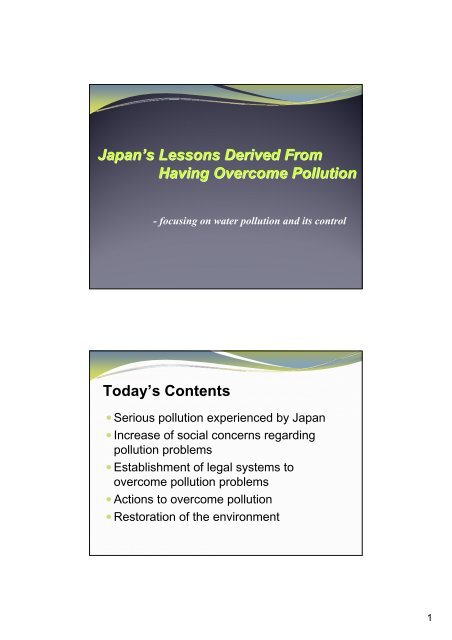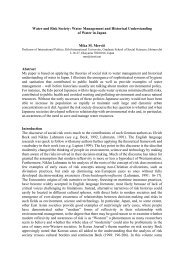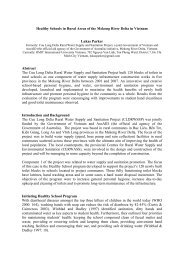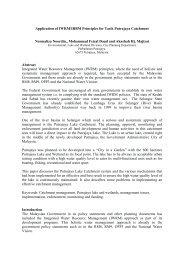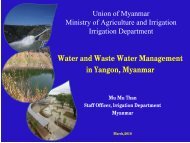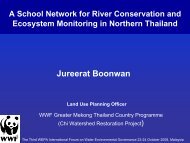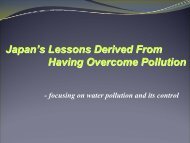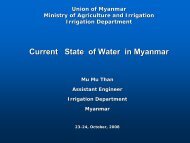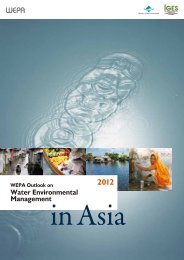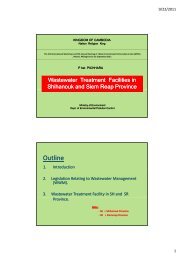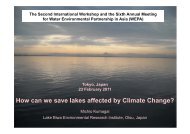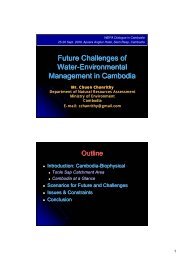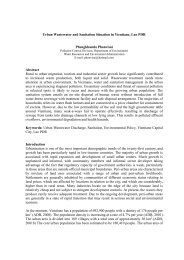3784KB - WEPA
3784KB - WEPA
3784KB - WEPA
You also want an ePaper? Increase the reach of your titles
YUMPU automatically turns print PDFs into web optimized ePapers that Google loves.
Japan’s s Lessons Derived FromHaving Overcome Pollution- focusing on water pollution and its controlToday’s Contents• Serious pollution experienced by Japan• Increase of social concerns regardingpollution problems• Establishment of legal systems toovercome pollution problems• Actions to overcome pollution• Restoration of the environment1
Serious damage from pollution (1)- Japan as a pollution island -Niigata MinamataDiseaseItai-Itai DiseaseMinamataDiseaseDamage by air pollution invarious locations, such asYokkaichi AsthmaSerious damage from pollution (2)- Itai-itai disease emerged -• Victims legally designated:about 200 persons• The total amount of damages(including damages to human health andagricultural production such as reduction ofyield and pollution of agricultural land):estimated around 50 billion yen3
Serious damage from pollution (3)- Minamata Disease emerged -Victims legally designated: about 3,000 persons The total amount ofdamages (including healthdamages, contamination ofsediment and damage tofisheries): estimatedaround 378.9 billion yen 5 suits are still on-going.(Number of plaintiffs is approx.1,500.)From Website of MinamataCityLegal systems in previous times- Previous two laws on water quality (1958) -• Law Concerning Water Quality Conservation forPublic Waters• Law Concerning Controls on Factory WastewaterProblems- To investigate problems, designate certain public water areas,and set water quality standards (effluent water standards) afterproblems are identified.“Follow-up approach”- Insufficient regulatory framework for compliance of effluent waterstandards- Pluralistic legal systems4
Water pollution spreads nation-wide• Areas designated by Water Quality Protection Law1962: 1 area → 1965: 9 areas →1970: 103 areas• Pollution of major rivers (BOD)* data of 1970Usable as a source ofpublic water supply:x
Competing between pollutionprevention and economic development- 1965: Establishment of Pollution Prevention Service Corporation→ to promote pollution control activities and support companies underregulation- 1967: Establishment of the Basic Law for Environmental PollutionControl→ Establishment of environmental standards and pollution control plan→ delay of action because of so-called “clause of harmonization witheconomic activities”Around 1970, pollution problems were getting more serious, such as“sludge problem” in Tagonoura Bay, photochemical smog, and leadpollution caused by emission gas from vehicles.Pollution session of the Diet andsocial changesJuly 1970: Establishment of Pollution Control OfficeHeaded by the Prime MinisterDec. 1970: Amendment of the Basic Pollution Control Law;amendment/establishment of pollution controlrelated laws (14 laws in total)- deletion of so-called “clause of harmonization ofeconomic activates”1971: Establishment of the Environment Agency- Growing social concerns regarding environmental problems* Coverage of environmental issues in newspapers (ratio of articlesrelated to environmental problems in newspapers)1960:0.4% → 1965:0.7% → 1970:2.8%* Opinion poll on the choice of pollution and industrial development1966:allowed = 29%, not allowed at all = 27%→ 1971:allowed = 13%, not allowed at all = 49%6
National effluent standardsThe Water Pollution Control Law sets out national effluent standardsapplicable to all Specified Facilities throughout Japan regardless of the typeof industry.Penal provisions are applicable for the mere act of exceeding theconcentration limit --- the so-called “direct penal system.”Factories/establishments(Without SpecifiedFacilities)PublicWaterAreaWastewaterWastewaterSpecifiedFactory(having a Specified Facility)UndergroundpenetrationA factory or an establishment thathas a Specified Facility is calleda Specified FactorySpecified Factories discharge pollutedwater into a Public Waters(wastewater)The standards under the WaterPollution Control Law apply toindustrial effluentNational effluent standards and add-on standardsNational Gov.Health itemsApplied to allfactories/establishmentsNational Effluent Standards(minimum control applied nationwide)Living environment itemsApplied to factories/establishments withwastewater discharge of 50 m 3 /day or moreLocal governments areauthorized to tighten controls,according to local conditionsLocal Gov.Add-ons by local governmentSet more stringent effluent standard values by prefectural ordinance if thenational flat wastewater standards are not sufficient to comply the water qualitystandards.“Hem down” by local governmentExtend application of the Living Environment Standards tofactories/establishments with less than 50 m 3 /day wastewater discharge“Side stretch” by local governmentIntroduce additional wastewater control items which are not covered by thenational effluent standards8
Efforts made by Private Sector (1)- agreement on environmental pollution control -- agreement between private sector and localgovernments/citizen’s groupFunctions of the agreement1) supplementary pollution controlmeasure2) implementation of pollutioncontrol with close attention tolocal conditions3) promotion of future pollutioncontrol measures anddevelopment of pollutionprevention technologies4) prevention of protests againstlocation of factories by gettingagreement from local residentsNumber of factories with agreementon pollution controlNumber of non-compliance casesEfforts Taken by Private Sector (2)- Investment to pollution control -Increase in the investment to pollution controlinvestment to pollution control (billion yen)government loan and investment (billion yen)ratio of pollution control investment (%)10
False economy of economic activities withoutdue consideration of the environment- Japanese Experience of Pollution Control (1991)Case ofpollutionMinamataDiseaseEconomic loss(yen/year)Expenditure forpollution control(yen/year)12.6 billion 0.1 billionItai-Itai Disease 2.5 billion 0.6 billionYokkaichiAsthma1.3 billionwithout anycountermeasures taken21 billion14.7 billion*The above values are 1989 price of equalized values of economic loss andactual pollution control expenditure with assumption that maturity period is 15to 30 years.SUMIDA RIVER in TOKYOSumida River became adesignated water area in 1964Tokyo Metropolitan Pollution ControlOrdinance was enacted in 19691971(From Website of Tokyo metropolitan)TODAY(From Website of Tokyo metropolitan)11
DOKAI BAY in KITAKYUSHUDokai Bay became adesignated water area in 19691960’s (From Website of Kitakyusyu City) TODAY(From Website of Kitakyusyu City)Current water quality in Japan- Water quality improved significantly over a period of aboutten years.* Pollution of major rivers (BOD) in 1970 and 1980:x
Tips for Pollution Control• Establishment of laws and regulations• Persistent guidance for factories andestablishments by public sector (beforepunishment)• Use of not only end-of-pipe technology butcleaner production technology• Wise use of water resources to reduce cost andpollution• Action - the sooner, the betterThank youfor your attention!14


